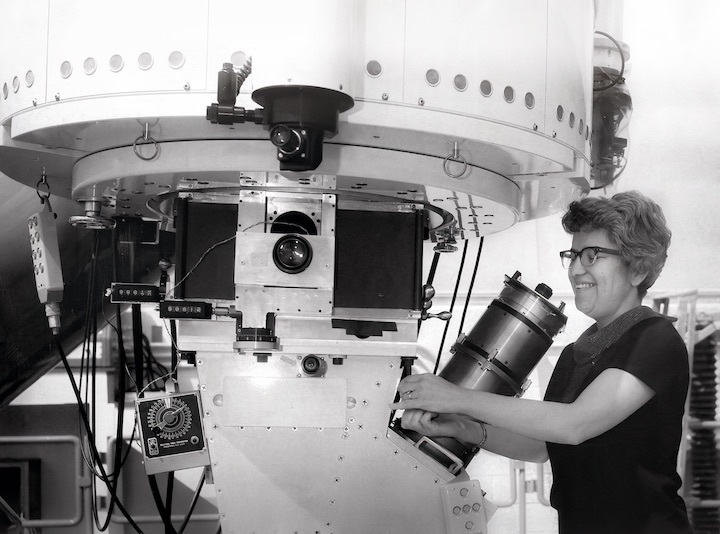14.01.2020

Vera Rubin operated the No. 1 36-inch telescope at Kitt Peak National Observatory. Kent Ford’s Image tube spectrograph is attached to the telescope.
Credit: NSF’s National Optical-Infrared Astronomy Research Laboratory/KPNO/AURA
Poised to conduct a vast, deep astronomical survey of the dynamic Universe from high in the Chilean Andes, the Large Synoptic Survey Telescope (LSST) will now be named the NSF Vera C. Rubin Observatory (also known colloquially as the Rubin Observatory). Rubin, one of history’s most influential female astronomers, played a critical role in demonstrating the existence of dark matter — one of many mysteries the NSF Vera C. Rubin Observatory is expected to help illuminate.
The announcement was made jointly by Ralph Gaume, Director of the NSF Division of Astronomical Sciences, Kathy Turner, DOE (Department of Energy) program manager of the Office of High Energy Physics and LSST Director Steve Kahn. “Named after an astronomer who provided important evidence of the existence of dark matter, the NSF Vera C. Rubin Observatory is set to make science history with its extraordinary capabilities that will come to bear in the next few years,” said France Córdova, director of NSF. “Congress has helped make this inspiring commemoration a reality. The Rubin Observatory is expected to significantly advance what we know about dark matter and dark energy, so the Rubin name will have yet another way to inspire women and men eager to investigate.”
Vera Rubin’s career spanned several areas in observational astronomy but she is most recognized for uncovering the discrepancy between the observed and predicted motions of matter in galaxies. This discrepancy is interpreted as evidence for dark matter, which exerts gravitational force but does not emit light as ordinary matter does. Her work was confirmed using numerous observational techniques and it has had a major impact on cosmology.
“We are pleased that LSST has now been named the Vera C. Rubin Observatory,” said Rubin’s sons Allan Rubin, David Rubin, and Karl Rubin. “We believe that this is a great way to honor our mother’s achievements in astronomy and her work for equal rights for women in science.”
The initiative to name the observatory in honor of Rubin began in June 2019 when House Science Committee Chairwoman Eddie Bernice Johnson and Congresswoman Jenniffer González-Colón proposed the idea. It was enacted into law on 20 December 2019 and represents the first national observatory named in honor of a woman. It is fitting that Rubin’s name is attached to an observatory in Chile, where women’s participation in astronomy has been comparatively strong.
The Rubin Observatory features facilities currently under construction in Chile which will be completed in 2022. It consists of an integrated system featuring a wide-field ground-based telescope with an 8.4-meter mirror. During 10 years of operation starting in 2022, the Rubin Observatory together with the 3,200 megapixel DOE LSST Camera and the data facility will carry out an unprecedented optical survey of the visible sky named the Legacy Survey of Space and Time (LSST). The design of the LSST survey is driven by four main science themes: probing dark energy and dark matter, taking an inventory of the Solar System, exploring the transient optical sky, and mapping the Milky Way. The science operations to deliver the LSST survey will be jointly funded by NSF and DOE.
The telescope at the Rubin Observatory is now named the Simonyi Survey Telescope in recognition of a significant private donation made early in the construction phase that was used to design, develop, and fabricate the telescope’s primary mirror.
“It is exciting that this wonderful observing system will be named after Vera Rubin. Dr. Rubin was a strong advocate of public facilities for science as a means of ensuring the best ideas got to see the light of day (or night). Much of her astronomy research was accomplished on NSF-funded, national facilities open to all astronomers, so having her name on this new NSF facility is appropriate and a great way to honor her work and impact on our field,” said Robert Blum, Acting Director of Operations at the Rubin Observatory.
Quelle: NSF
